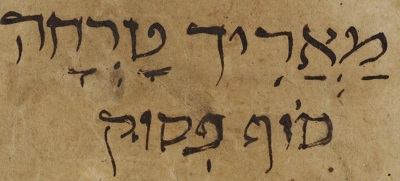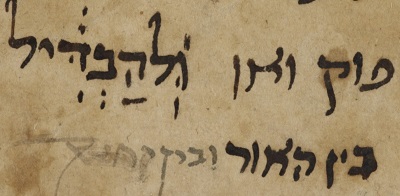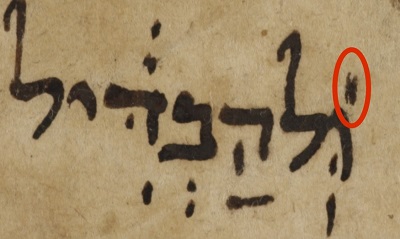Reciting Hebrew with an Arabic Accent: A Partial List of Ṭeʿamim from T-S K9.11
Nick Posegay, University of Cambridge
Introduction
A few weeks ago, while re-measuring folios and formatting .rtf documents on an otherwise pleasant summer afternoon, I came across a curious fragment from a list of Hebrew accent signs (ṭeʿamim). These types of lists are not particularly rare in the Geniza collection, and most offer little more than the accents already known from biblical recitation traditions, but this one caught my eye. The extant section contains just six lines of text – a total of four accents – but the final one stands out from the typical names: maqqaf hamza (מַקַּף הַמְזה). Maqqaf is a nominal form from the root n-q-p, related to “bringing close together.” It shares this root with what we now know as the maqqef (“hyphen”) sign in Hebrew, although that is not the sign that appears in this list. Then hamza is not a Hebrew or Aramaic word at all, but rather is the name of the Arabic letter which usually represents a glottal stop (ء).
Description
This fragment is paper, 14 x 12.9 cm, and the verso is mostly blank, save for a few jottings. It is slightly stained with a few small holes, but has no damage that obscures the text. The first three lines are in large, semi-cursive Hebrew,[1] while the final three lines switch to Judaeo-Arabic in smaller square script. The Hebrew lines list three common accents, using the Sefardi names maʾarik (מַאֲרִיך; Ashkenazi merka), ṭarḥa (טָרְחָה; Ashkenazi ṭifḥa), and sof pasuq (סוֹף פסוּק), all followed by the maqqaf hamza (מַקַּף הַמְזה). This fragment was written by the same hand as T-S NS 301.82, which includes a similar list of accents, but that leaf is considerably larger than T-S K9.11, so they are probably not from the same manuscript.

Figure 1: Names of three Sefardi accents.
After the accent names, the Judaeo-Arabic explains how the maqqaf hamza sign is supposed to look, quoting Genesis 1:18. A second hand, writing in lighter gray ink, extends the text of this verse, and seems to incorporate some Arabic script into the final word before abandoning the work.

Figure 2: Part of Genesis 1:18, written by two different hands.
Based on the paper, script-style, and use of Sefardi terminology, this fragment was probably produced between the twelfth and fourteenth centuries.
Maqqaf Hamza
These types of accent lists often place each accent’s respective grapheme on the text of its name, but T-S K9.11 does not do that for its first three accents. By contrast, for maqqaf hamza, it does include a short vertical stroke above the word hamza, which appears to be its sign.

Figure 3: The sign of the maqqaf hamza.
The author then offers a Judaeo-Arabic explanation of the accent, saying that it is: mithl al-ʿaṣā aladhī fawqa vav וּֽלֲהַבְדִּ֔יל בֵּ֥ין הָא֖וֹר. That is, “like the staff which is above the vav of u-la-habdil beyn hɔ-ʾor,” citing Genesis 1:18. ‘Staff’ (ʿaṣā) here is literally a stick or rod, and it represents the shape of the maqqaf hamza sign. Accordingly, while this fragment includes the standard accent signs on וּֽלֲהַבְדִּ֔יל, it also adds a single vertical stroke above the vav, which does not appear in the Masoretic text.

Figure 4: A maqqaf hamza sign in Genesis 1:18.
The irregularly tapered ends of this stroke match the jagged edges of some of the vowel signs earlier in the text, probably caused by a crack in the nib of the writer’s pen. This detail suggests that the maqqaf hamza grapheme is original to this list, and not a later addition by another hand.
Unfortunately, the Judaeo-Arabic explanation only tells us the shape of the maqqaf hamza sign, not its function. Despite this deficiency, the name maqqaf hamza and the context of its placement in Genesis 1:18 make the intended usage clear. The Hebrew phrase u-la-habdil is irregular in that, unlike the vast majority of Hebrew words, it appears to begin with a vowel. In fact, the medieval grammarian Saadia Gaon (d. 942) specifically forbids such a situation, and states that one of the fundamental rules of phonology is that an utterance cannot begin with a vowel sound. He clarifies that if someone tried to begin an utterance with a vowel, “then it would appear to the one who hears their utterance to just be one of the discrete letters, that is: אא או בא בו.”[2] Another medieval linguist offers a similar solution to this predicament. In the Treatise on the Shewa (late ninth or tenth century), the anonymous author explains that in order to say וּבָנָה, “you pronounce it with אוּ, as if you were saying אֻבָנָה.”[3] In this case, they render the pronunciation of the initial U-vowel with the additional of the full letter aleph. However, the author also specifies that וּבָנָה and similar forms did not begin with a true glottal stop, and the aleph in אֻבָנָה is just an approximation.[4]
Regardless of the exact pronunciation of the initial vav in words like וּבָנָה and וּלהבדּיל, it is clear that at least some medieval linguists believed that aleph could help explain that pronunciation. On a basic phonetic level, the Hebrew aleph (א) is the equivalent of the Arabic hamza (ء), but the Classical Arabic hamza also has an additional form, known as hamza al-waṣl (‘the hamza of connecting’). Hamza al-waṣl usually has no phonetic value, and it only appears at the beginning of words, always atop the letter alif (ٱ). It normally indicates a connection of the final vowel of the previous word with the first consonant after the hamza al-waṣl. In certain situations, though,[5] the hamza al-waṣl takes on the function of a normal hamza, and is pronounced like a glottal stop to facilitate a vowel sound at the beginning of a word. It seems then that the accent name maqqaf hamza (‘connector of hamza’) is a Hebrew rendering of hamza al-waṣl, and the author of the list in T-S K9.11 intends for the vertical maqqaf hamza ‘accent mark’ above vav to specify a word-initial vowel sound. Such a specification is particularly important in Genesis 1:18, as the initial lamed of la-habdil is not one of the letters that typically causes conjunctive vav to lose its labiodental pronunciation (i.e. bet, mem, and pe).
This ‘accent’ does not appear in the standard Masoretic text, and yet the author includes it in their list along with the other Hebrew and Aramaic ṭeʿamim. This fact suggests that members of at least one tradition of biblical recitation were familiar with Classical Arabic orthography and terminology, and they adapted it for use in their Hebrew accent system. It is difficult to make any further conclusions based on T-S K9.11 alone. I know of no other texts that use or refer to the maqqaf hamza, so this tradition could have been relatively small, perhaps limited to a single community or village. On the other hand, it may have been quite common, and we simply have limited evidence of maqqaf hamza in the manuscript record due to the dominance of the “standard” Masoretic text. In either case, for both Hebrew and Arabic, this hamza was truly an accent of connection.
Footnotes
[1] Possibly in a Sefardi script-style, although the hand is not professionally trained. My thanks to Estara Arrant for this identification.
[2] Solomon L. Skoss, “A Study of Hebrew Vowels from Saadia Gaon’s Grammatical Work ‘Kutub al-Lughah,’” The Jewish Quarterly Review 42, no. 3 (January 1952): 290, lines 10–14, https://doi.org/10.2307/1452840.
[3] Kurt Levy, ed., Zur Masoretischen Grammatik: Texte Und Untersuchungen, Bonner Orientalische Studien 15 (Stuttgart: W. Kohlhammer, 1936), כז, line 10.
[4] Khan, Geoffrey. The Tiberian Pronunciation Tradition of Biblical Hebrew. Semitic Languages and Cultures 1. Cambridge: University of Cambridge & Open Book Publishers (forthcoming), “Vav (ו).” Khan proposes that this type of conjunctive vav with shewa was probably pronounced [wu], at least in the Tiberian reading tradition.
[5] For example, in the imperative of some form-I verbs and the passive of form-VIII and form-X perfect verbs.
Cite this article
Posegay, N. (2019). Reciting Hebrew with an Arabic Accent: A Partial List of Ṭeʿamim from T-S K9.11. [Genizah Research Unit, Fragment of the Month, July 2019]. https://doi.org/10.17863/CAM.49265
If you enjoyed this Fragment of the Month, you can find others here.
Contact us: genizah@lib.cam.ac.uk
